
i
In cases such as the one mentioned
above, contact an authorized Mercedes-
Benz Center. Or call 1-800-FOR-MERCedes
(in the USA) or 1-800-387-0100 (in Can-
ada).
X
Correct the tire pressure if it is still at least
130 kPa (1.3 bar/19 psi). See the Tire and
Loading Information placard on the driver's
side B-pillar or the tire pressure table in the
fuel filler flap for values.
X
To increase the tire pressure:
switch on
the tire inflation compressor.
X
To reduce the tire pressure:
open release
screw
C
.
X
When the tire pressure is correct, unscrew
the filler hose from the valve of the sealed
tire.
X
Screw the valve cap onto the tire valve of
the sealed tire.
X
Unscrew the tire sealant bottle from the tire
inflation compressor.
X
Drive to the nearest qualified specialist
workshop and have the tire changed there.
X
Have the tire sealant bottle replaced as
soon as possible at a qualified specialist
workshop.
X
Have the tire sealant bottle replaced every
four years at a qualified specialist work-
shop.
Battery (vehicle)
Important safety notes
Special tools and expert knowledge are
required when working on the battery, e.g.
removal and installation. You should there-
fore have all work involving the battery car-
ried out at a qualified specialist workshop.
G
WARNING
Work carried out incorrectly on the battery
can lead, for example, to a short circuit and
thus damage the vehicle electronics. This can
lead to function restrictions applying to
safety-relevant systems, e.g the lighting sys-
tem, the ABS (anti-lock braking system) or the
ESP
®
(Electronic Stability Program). The oper-
ating safety of your vehicle may be restricted.
You could lose control of the vehicle, for
example:
R
when braking
R
in the event of abrupt steering maneuvers
and/or when the vehicle's speed is not
adapted to the road conditions
There is a risk of an accident.
In the event of a short circuit or a similar inci-
dent, contact a qualified specialist workshop
immediately. Do not drive any further. You
should have all work involving the battery car-
ried out at a qualified specialist workshop.
i
For further information about ABS and
ESP
®
, see (
Y
page 60) and (
Y
page 63).
H
Environmental note
Batteries contain dangerous
substances. It is against the
law to dispose of them with
the household rubbish. They
must be collected separately
and recycled to protect the
environment.
Dispose of batteries in an
environmentally friendly
manner. Take discharged
batteries to a qualified spe-
cialist workshop or a special
collection point for used bat-
teries.
!
Have the battery checked regularly at a
qualified specialist workshop.
Observe the service intervals in the Main-
tenance Booklet or contact a qualified spe-
cialist workshop for more information.
!
You should have all work involving the
battery carried out at a qualified specialist
workshop. In the exceptional case that it is
necessary for you to disconnect the battery
yourself, make sure that:
Battery (vehicle)
215
Breakdown
assis
tance
Z
Summary of Contents for GT S 2016
Page 4: ......
Page 70: ...68...
Page 88: ...86...
Page 98: ...96...
Page 160: ...158...
Page 184: ...182...
Page 185: ...Useful information 184 Stowage areas 184 Features 186 183 Stowage and features...
Page 200: ...198...
Page 210: ...208...
Page 268: ...266...
Page 269: ...267...
Page 270: ...268...
















































